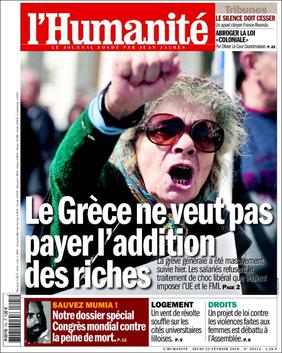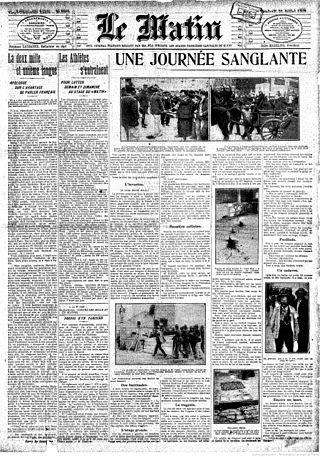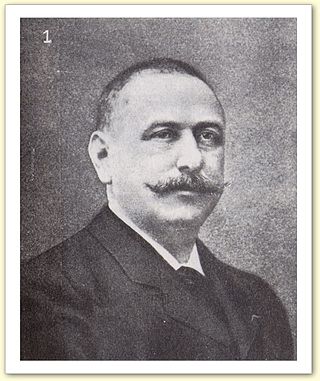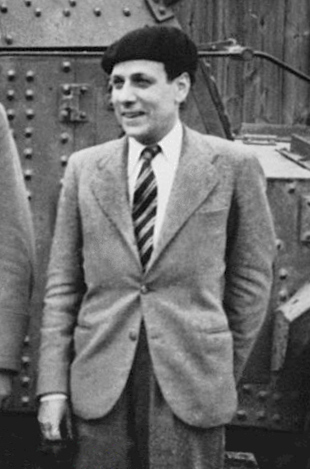
L'Humanité is a French daily newspaper. It was previously an organ of the SFIO, de facto, and thereafter of the French Communist Party (PCF), and maintains links to the party. Its slogan is "In an ideal world, L'Humanité would not exist."

Le Temps was one of Paris's most important daily newspapers from 25 April 1861 to 30 November 1942. It was a serious paper of record.

Diário de Notícias is a Portuguese daily newspaper published in Lisbon, Portugal. Established since 1864, the paper is considered a newspaper of record for Portugal.
Le Matin is a daily francophone Saudi-owned Moroccan newspaper. It was founded on 1 November 1971, as replacement of pro-colonial daily Le Petit Marocain, whose publisher Mas Presse was seized and given to the cousin of Hassan II and his minister of communication Moulay Hafid Alaoui.

Le Petit Journal was a conservative daily Parisian newspaper founded by Moïse Polydore Millaud; published from 1863 to 1944. Together with Le Petit Parisien, Le Matin, and Le Journal, it was one of the four major French dailies. In 1890, during the Boulangiste crisis, its circulation first reached one million copies. Five years later, it had a circulation of two million copies, making it the world's largest newspaper.

Le Matin was a French daily newspaper first published in February 26, 1884, and discontinued in 1944.
Sud Ouest is a daily French newspaper, the second largest regional daily in France in terms of circulation. It was created in Bordeaux, on August 29, 1944, by Jacques Lemoine, as a successor to La Petite Gironde. In 1949, the Sunday edition, Sud Ouest Dimanche was launched. Sud Ouest covers the Gironde, the Charente, the Charente-Maritime, the Dordogne, the Lot et Garonne, the Landes and the Pyrénées Atlantiques départements. It is owned by the Groupe Sud Ouest, which was directed by Jacques Lemoine from 1944 to 1968, and by his son Jean-François Lemoine from 1968 to 2001. The president of the group since February 2008 has been Pierre Jeantet. 80% of the group belongs to the Lemoine family, 10% to the journalists, and the remaining 10% to the staff.

Pierre Giffard was a French journalist, a pioneer of modern political reporting, a newspaper publisher and a prolific sports organiser. In 1892, he was appointed Chevalier (Knight) of the Légion d'Honneur and in 1900 he was appointed an Officier (Officer) of the Légion d'Honneur.

René-Paul Schützenberger was a French Post-Impressionist painter.

L'Aurore was a French newspaper first sold on 11 September 1944, soon after the Liberation of Paris. Its name refers to the previous, unrelated publication, L'Aurore (1897–1914). Publication ended in 1985.

Claude Jeantet was a French journalist and far-right politician.

Newspapers have played a major role in French politics, economy and society since the 17th century.

Jeanne-Henriette Tirman was a French woman painter and printmaker.

Le Petit Provençal was a French provincial daily newspaper founded in Marseille in 1880. It took a Left Republican position, although it was never an official socialist organ. In the years before World War I (1914–18) many prominent politicians contributed to the paper. The paper opposed the pact between Germany and Russia just before World War II (1939–45), and after the fall of France opposed the Vichy regime. However, it managed to continue publication until 1944.
Fernand Desnoyers, full name Félix-Emile-Arthur Desnoyers, was a 19th-century French writer and literary critic.

Andrée Viollis was a French journalist and writer. A prominent figure in news journalism and major reporting, she was an anti-fascist and feminist activist who was part of the French group associated with the World Committee Against War and Fascism. Viollis worked for various newspapers, including La Fronde, L'Écho de Paris, Excelsior, Le Petit Parisien, The Times, Daily Mail, Vendredi, Ce soir, and L'Humanité. She received several awards, including the Legion of Honour.

The clandestine press of the French Resistance was collectively responsible for printing flyers, broadsheets, newspapers, and even books in secret in France during the German occupation of France in the Second World War. The secret press was used to disseminate the ideas of the French Resistance in cooperation with the Free French, and played an important role in the liberation of France and in the history of French journalism, particularly during the 1944 Freedom of the Press Ordinances.

Pierre Antoine Baptiste René Lafitte was a French journalist, publisher and editor born 3 May 1872 in Bordeaux and died 13 December 1938 in Paris. He innovated in illustrated press and popular novel formats in France.
Marianne was a weekly Paris-based French illustrated magazine that appeared in France, between 1932 and 1940.
















